Wednesday 20 May 1942
Battle of the Pacific: Admiral Nimitz approves a secret operation on 20 May 1942 to ascertain Japanese plans. One of the codebreakers in the Honolulu station, Jasper Holmes, has come up with a way to ascertain the location of "AF," known from decrypts to be the target for an upcoming Japanese invasion. Using an undersea cable that is known to be secure, Nimitz today sends a message to the Midway Island base commander telling him to send out a radio message that there is a "water shortage" at the island. "At the present time, we have only enough water for two weeks. Please supply us immediately."
Just to make certain the intended Japanese recipients get the radio message, the island commander also is instructed to send the request for help both in a code the Japanese are known to have broken and "in the clear" (without coding). The US naval intelligence offices in three locations - Melbourne, Honolulu, and Washington - then sit back to see what develops.
The Japanese indeed are preparing an offensive operation against Midway. Today, Admiral Yamamoto sends out Operational Order 14. This details a complex plan to coordinate invasions of the Aleutian Islands and Midway with troops from Saipan.
A Yeoman in the US Navy Fleet Radio Unit in Melbourne, Australia (FRUMEL), Bill Tremblay, is working late. At 23:30, he identifies Yamamoto's message as important even though it is badly garbled. After Tremblay discusses it with his superiors, the message is put on a fast track for decryption. That, however, will take several days. The Honolulu station also intercepts a copy of the message which also is garbled, but largely in different places. Between the two interceptions, a large portion of the lengthy message can be decrypted.
B-17s based in Australia bomb the airfield at Koepang, Timor, continuing a series of missions against the base. These missions are effective at silencing antiaircraft guns at the airfield.
Battle of the Indian Ocean: Today is generally viewed as the completion of the Japanese conquest of Burma. The British formally dissolve Burma Corps, transferring all soldiers formerly under General William Slim to the British IV Corps. Slim is reassigned to Indian XV Corps.
Meanwhile, India is receiving a steady flow of reinforcements from the United States. Another unit of the 10th Air Force in the China-Burma-India Theater arrives at Karachi, India, from the US today. It is the 11th Bombardment Squadron, 7th Bomber Group (Heavy), and flies B-17s. The 11th will become active and fly its first mission on 3 June 1942
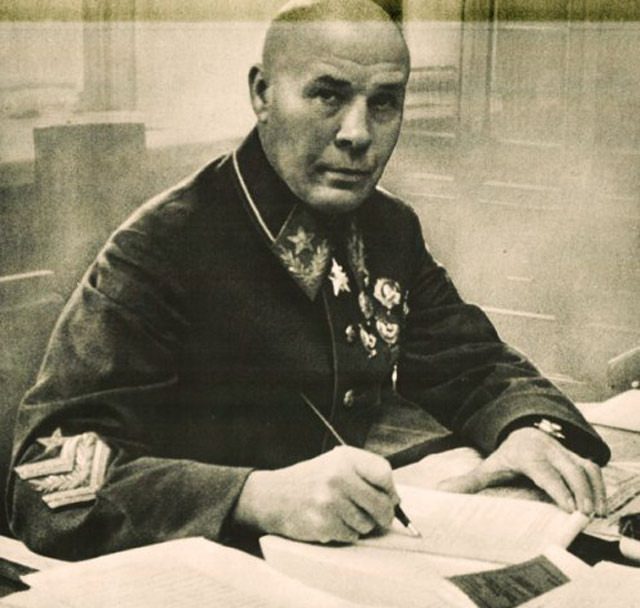 |
| The troops of Soviet Marshal Timoshenko, shown, are in big trouble around Kharkov on 20 May 1942. |
Eastern Front: The Wehrmacht commits more units to its attempt to encircle the Red Army troops wheeling about in confusion south of Kharkov. The Luftwaffe is particularly effective at sealing the pocket, sending Junkers Ju 87 Stukas from StG 77 to destroy five of the Soviet bridges across the Donets River and damage four others. Kampfgeschwader 3 (KG 3), meanwhile, focuses on the roads in the developing pocket that are crowded with Soviet columns that have belatedly been turned 180 degrees to face the growing threat to their communications. Such a maneuver is difficult even in normal times, as the roads east are crowded with service troops, equipment, and other obstacles. The going is slow, and the Soviets are running out of time.
Turning an army around is one of the most difficult maneuvers in warfare. The entire orientation is inverted, with the cutting edge of tanks, infantry, and artillery having to reverse course in a perfectly coordinated ballet that is difficult in peacetime, let alone under fire. The army's "tail," or supply establishment, likewise has to change position to be just the right distance from the front line - which is moving who knows where. Ammunition dumps wind up in the wrong places, headquarters have to move and are out of touch, unit commanders don't even know where their soldiers are. Add to that blocked roads through rough terrain caused by air and artillery attacks and it's easy for chaos to erupt. This is exactly what happens to the Red Army south of Kharkov in May 1942.
Fulfilling a direct order from Field Marshal Fedor von Bock, the 14th Panzer Division advances further north from Petrovskoye and takes Protopopovka. This eliminates another key Soviet Donets river crossing and narrows the mouth of the breakthrough from there to Balakleya down to a dozen miles.
The Germans, though, are running a big risk. They are drawing only a thin line between the huge Red Army forces to the east and west. It is eight miles long and, in most places, only two miles wide. This easily could be pierced by fierce Red Army attacks. The German III Panzer Corps heads west to try and expand the width of this cordon. However, the Germans have to rely on Romanian troops that are less than enthusiastic to stick their heads into this potential noose (at Fuhrer headquarters, General Franz Halder notes that "the Romanians have gained only a little ground").
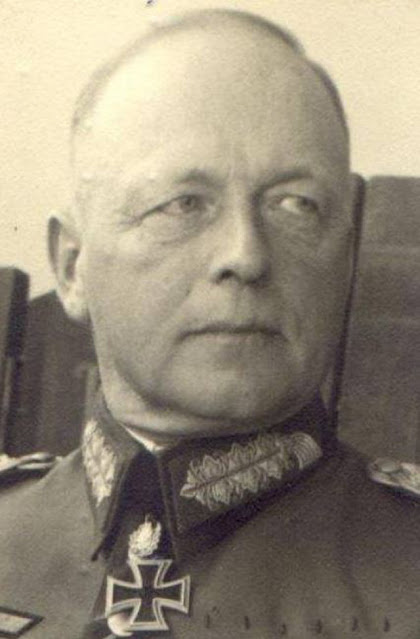 |
| Von Kleist. |
Determined to seal his victory, General Ewald von Kleist risks it all and sends the 16th Panzer Division (General Hube), the 60th Motorized Division, and the 1st Mountain Division to support the exposed 14th Panzer Division. These are the best troops in the First Panzer Army, the cream of the Wehrmacht. It is a huge gamble because Soviet counterattacks from either or both sides easily could cut off all of these divisions in the exposed salient. This would turn German victory into defeat. Bock convinces Sixth Army commander Friedrich Paulus (direct orders don't always work in these situations even in the Wehrmacht), whose troops are north of the bulge, to support this ambitious move by releasing the 3rd and 23rd Panzer Divisions. They will advance south from Balakleya and meet Kleist's advancing panzers. Even if they meet, however, it is unclear if they can hold their positions against furious counterattacks. It is an audacious gambit.
Someone is going to have a massive victory that may decide the entire summer campaign. It's just not perfectly clear yet who that will be. How hard the Red Army on opposite sides of the German advance will resist this encircling move is the big imponderable.
Bock knows the decisive moment of the entire campaign, perhaps the entire war has arrived. He writes in his war diary, confidently but perhaps more hopefully:
[T]tonight I have given orders aimed at completely sealing off the Izyum bulge. Now everything will turn out well after all.
Only one thing stands in Bock's path to victory: the Red Army. However, something strange is going on. The Germans are astonished to see no signs of either a determined breakout or a relief attack from the East. The thin German lines are holding and consolidating even though they are outgunned and outmanned by enemy troops just out of sight. It's a mystery that only deepens.
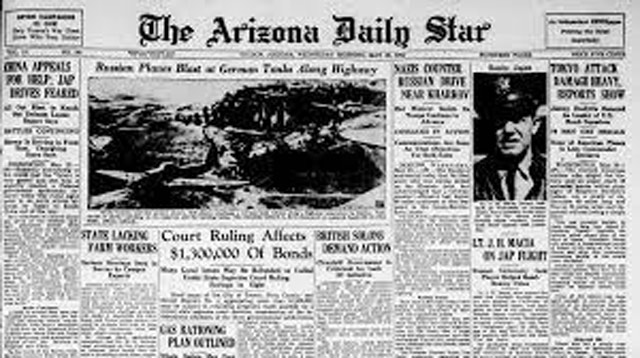 |
| The Arizona Daily Star of 20 May 1942 features news from the Eastern Front battle of Kharkov that suggests the Red Army is doing well there. "Russian Planes blast at German Tanks Along Highway." |
General Manstein's 11th Army eliminates the final above-ground pocket of Soviet resistance south of Kerch today (there are still Red Army soldiers operating out of catacombs in the region). The German success in the Kerch peninsula means many Luftwaffe resources can be transferred to the Kharkov battle, but there is still unfinished business in Crimea to the west. Luftwaffe ace Gordon "Mac" Gollob completes one of the longest sustained victory streaks of the war by shooting down two enemy aircraft, a DB-3 and a LaGG-3. This gives him 101 victories, a major milestone, and 14 victories over the past five days since taking command of JG 77. Gollob is the tenth Luftwaffe pilot to reach the century mark. After these victories, JG 77 is transferred west to help with the conquest of Sevastopol.
The German victory in the Kerch peninsula now is complete. It was an overwhelming triumph. While Fliegerkorps VIII has lost 37 aircraft, the Soviets lose 417. While between 37,000 and 116,045 Red Army soldiers make it back to the mainland, an estimated 162,282 do not. The Germans take about 150,000 soldiers and others (many are civilians) prisoner. The 11th Army loses only 7588 men in total, about ten tanks, and a dozen artillery pieces. The Soviets effectively lose three armies and nine divisions, with nine other divisions requiring major rebuilding.
European Air Operations: There are no major raids by either side today, perhaps due to the weather. The RAF's 197-plane raid on Mannheim on the night of 19/20 May accomplishes very little and causes only two fatalities in the city.
During an intruder operation to Soesterberg Airfield, German Flak of the 2./leichte Flak-Abteilung 764 downs an RCAF Douglas DB-7B Boston Mk III. All three crewmen perish.
 |
| MV Norland on fire and sinking after being torpedoed by U-108 on 20 May 1942. |
Battle of the Atlantic: German raider Michel shells and sinks 4245-ton Norwegian freighter Kattegat in the South Atlantic. Michel's crew takes the entire 32-man crew of Kattegat as prisoners.
U-108 (KrvKpt. Klaus Scholtz), on its seventh patrol out of Lorient, torpedoes, shells, and sinks 8134-ton Norwegian tanker Norland in the mid-Atlantic. Norland is part of Convoy ON 93. The entire 48-man crew survives and is rescued by Dutch freighter Polyphemus and USS PT-453.
U-753 (KrvKpt. Alfred Manhardt von Mannstein), on its fourth patrol out of La Pallice, gets its first victory of the wary. It torpedoes and sinks 7191-ton US Liberty ship George Calvert in the Caribbean near the Yucatan Channel. There are three deaths and 48 survivors.
U-155 (Kptlt. Adolf Cornelius Piening), on its second patrol out of Lorient, torpedoes and badly damages 7797-ton Panamanian tanker Sylvan Arrow in the Caribbean southwest of Grenada. There are one death and 43 survivors, who are picked up by the destroyer USS Barney. Sylvan Arrow sinks while under tow on 28 May.
U-506 (Kptlt. Erich Würdemann), on its second patrol out of Lorient, torpedoes and sinks 6986-ton US tanker Halo 50 miles south of Louisiana. There are 39 deaths and three survivors, who are rescued by Mexican freighter Oaxaca and British freighter Otina. This is the ninth victory of the patrol for U-506 and it isn't over yet. The wreck of the Halo, which was carrying 64,103 barrels of crude oil, is found during a pipeline survey in July 2000 lying in 470 feet (78 fathoms, 143 m) of water.
U-158 (Kptlt. Erwin Rostin), on its second patrol out of Lorient, torpedoes and sinks 8,113-ton British tanker Darina 500 nautical miles (930 km) southeast of Bermuda. There are six deaths and 50 survivors, who are rescued by British freighter British Ardour, Norwegian freighter Dagrun, and US freighter Exanthia. This is the first victory of what will be an eventful patrol for U-158.
US Navy yard patrol craft USS YP-387 sinks after colliding with collier Jason off Delaware. There are six deaths and 15 survivors who are rescued by Jason.
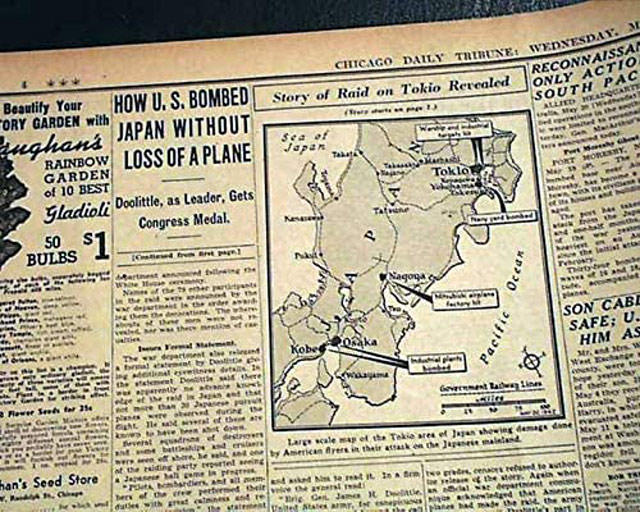 |
| The 20 May 1942 Chicago Daily Tribune contains a map and account of the 18 April Doolittle Raid on Japan. |
Battle of the Mediterranean: U-431 (Kptlt. Wilhelm Dommes), on its sixth patrol out of La Spezia, torpedoes and sinks 4216-ton British tanker Eocene off Sollum, Egypt. The tanker is part of convoy AT-46. All 43 crewmen survive, rescued by Royal Navy HMT Cocker.
Due to a large number of RAF Supermarine Spitfires now on Malta, the Axis bombing raids now are usually composed of hit-and-run attacks by Luftwaffe fighter-bombers. The main objectives are still the airfields, and Luqa Airfield is attacked several times today after dark. Compared to the situation of a month ago, however, the attacks are minor and cause little damage.
Battle of the Baltic: Norwegian (Axis) freighter Vestra hits a mine and sinks in the Skagerrak near the Falsterbo Lighthouse, Sweden. The ship sinks in shallow water and is refloated, repaired, and returned to service.
Anglo/Soviet Relations: Soviet Foreign Minister Vyacheslav Molotov arrives in London to hold talks on opening a second front. Churchill does not take to Molotov, later saying about him, "I have never seen a human being who more perfectly represented the modern conception of a robot." (WSC, WWII, Vol. I p. 288-9). Molotov, as usual, is all business, just as he was with Hitler in November 1940. He emphasizes Soviet claims on territory in Poland and the Baltic States, matters that Churchill views as premature. Despite their issues, the two men immediately begin work toward preparing a twenty-year treaty of friendship. The final agreement is signed on 26 May 1942.
US Military: The US Navy Department issues a press release on 20 May 1942, "Recruiting of [African Americans] to Begin June 1." It also releases a separate press release, "Marines Announce Plans for Recruiting [African Americans]."
The new Navy recruits are to receive the normal eight weeks of training at the established Great Lakes facilities. This will qualify them for a sixteen-week vocational school at the Hampton Institute in Virginia. They will be trained there as electricians, carpenters, ship fitters, machinists, metalsmiths, firemen, and cooks. Heretofore, African Americans in the Navy have been confined to the stewards' branch. Fearful of crew shortages in this area, the Navy refuses to allow transfers out of the stewards' branch to the general service until May 1945.
The black Marine Corps recruits have a somewhat different experience. The Marine Corps does not have a training center prepared, so the recruits must be placed on inactive duty status while one is set up. Eventually, a facility is constructed at Montford Point, near New River, North Carolina, and Camp Lejeune. Prospective Marine Corps recruits face often insurmountable obstacles such as tight quotas for black marines and other restrictions.
Admiral John S. McCain arrives at Noumea, New Caledonia, in seaplane tender USS Tangier. He assumes command as the new Commander Aircraft South Pacific Forces (COMAIRSOPAC). McCain now is responsible for tender and shore-based aviation in the South Pacific Area (SOPAC) under admiral Nimitz. This area is to the east of the Southwest Pacific Area and south of the Central Pacific Area. SOPAC encompasses the Ellice, Phoenix, Marquesas, Tuamotu, Samoa, Fiji, and New Hebrides island groups plus New Caledonia and New Zealand. However, it does not yet include Guadalcanal or Tulagi and thus does not include areas of likely conflict. It includes, though, the main route from the United States to Australia and is of immense strategic importance.
Submarine USS Kingfish (SS-234) is commissioned.
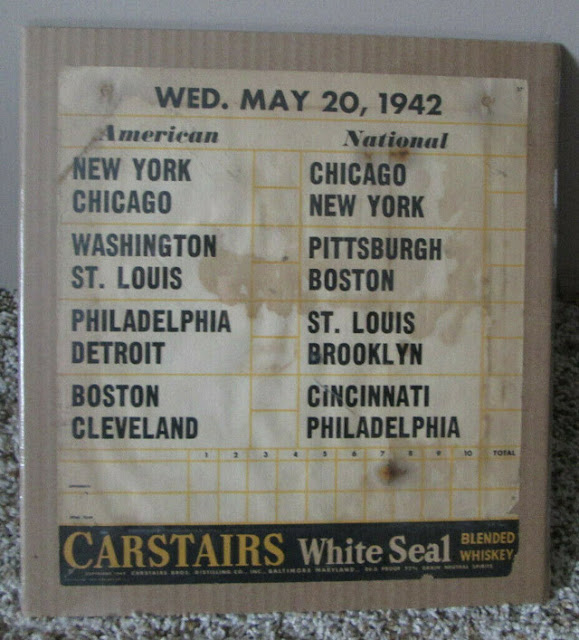 |
| The Major League Baseball schedule for 20 May 1942, sponsored by Carstairs White Seal Blended Whiskey. |
British Government: A two-day debate on the war situation concludes in Parliament. PM Leslie Hore-Belisha, the Secretary of State for War under former Prime Minister Neville Chamberlain, is particularly critical of the Churchill government's handling of the war situation. He notes that there is not yet a "method of continuous cooperate" with the United States and that the different Allies are speaking with "disunited voices." Hore-Belisha proposes government reforms that will maintain "a clear-cut distinction" between "impartial, undiluted military opinion and what is a political decision." This is an obvious attack on Churchill, who is suspected by some of managing the war for his own personal political benefit.
American Homefront: Henry Ford begins the construction of a memorial to inventor George Washington Carver in Greenfield Village adjacent to the Logan County Courthouse. This project has been Ford's dream since meeting Carver, who is still alive to watch the building go up and be completed, in 1937.
Future History: Carlos Norman Hathcock is born in Little Rock, Arkansas. He joins the US military during the Vietnam War and becomes a Marine Corps Gunnery Sergeant. He earns the nickname "White Feather Sniper" due to his habit of wearing a bush hat with a feather in it. Hathcock becomes a legendary sniper, and the Viet Cong place a $30,000 bounty on him. In his most famous encounter, he is sent specifically to eliminate an elite Viet Cong sniper known as "The Cobra." He accomplishes the task with a bullet that travels up Cobra's scope and into his eye. Carlos Norman Hathcock survives the war and passes away on 23 February 1999.
 |
| West Coast internees bound for a camp. (Dorothea Lange, Woodland, California, May 20, 1942. Courtesy National Archives and Records Administration). |




Very well done!
ReplyDelete